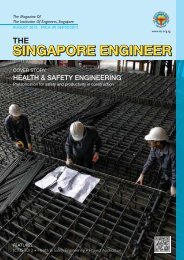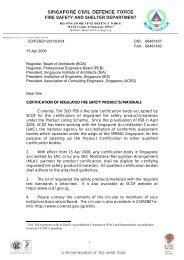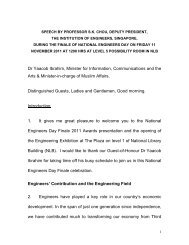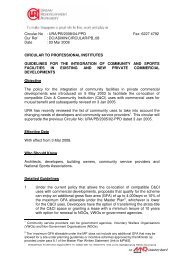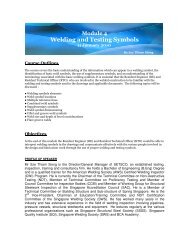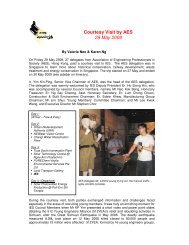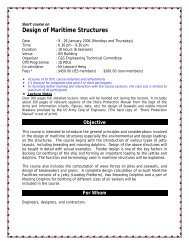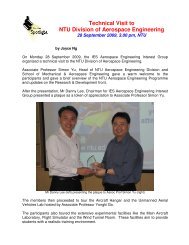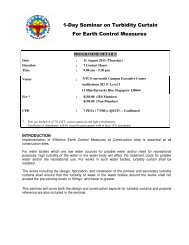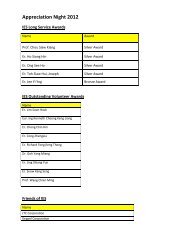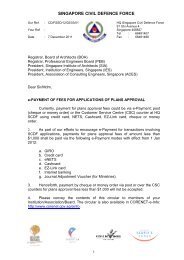THE SINGAPORE ENGINEER - Institution of Engineers Singapore
THE SINGAPORE ENGINEER - Institution of Engineers Singapore
THE SINGAPORE ENGINEER - Institution of Engineers Singapore
Create successful ePaper yourself
Turn your PDF publications into a flip-book with our unique Google optimized e-Paper software.
SYSTEMS COVER <strong>ENGINEER</strong>ING<br />
STORY<br />
Complete landscape <strong>of</strong> requirements and definitions documentation.<br />
is developed, the level <strong>of</strong> uncertainty associated with the status<br />
needs to be understood. Other work carried out by the writer,<br />
in Rolls-Royce, beyond the scope <strong>of</strong> this article, has formalised<br />
this in guidance documentation. This process has not been<br />
detailed here, as it needs to be aligned with an organisation’s<br />
internal trading processes. However, the principles will be the<br />
same whereby requirements will be traded, relaxed and/or<br />
more effort applied to achieving compliance.<br />
The issue <strong>of</strong> uncertainty is an important consideration in<br />
planning activities in the development <strong>of</strong> a complex system 5 .<br />
The information model described above gives a good<br />
framework for the assessment <strong>of</strong> uncertainty. Uncertainty<br />
can come in many forms.<br />
• Uncertainty in the requirement - either the stakeholder has<br />
not fully defined the requirement, or there is knowledge<br />
that it is likely to change, or it is new or novel and not fully<br />
understood, or it is challenging the bounds <strong>of</strong> feasibility.<br />
• Uncertainty in the evidence - there is uncertainty as to<br />
whether the evidence has the appropriate level <strong>of</strong> pedigree<br />
to show that the requirement has been/will be met - the<br />
means <strong>of</strong> producing the evidence may be new or outside<br />
calibration.<br />
• Uncertainty in the solution - the solution type may be novel<br />
or new, and so compliance with the requirements and/or the<br />
impact on other aspects <strong>of</strong> the system (particularly interfaces /<br />
interactions with other parts <strong>of</strong> the system) may be uncertain.<br />
With a technical review <strong>of</strong> a system, this framework again<br />
gives an opportunity to assess from a Systems Engineering<br />
perspective. The first issue should be an examination <strong>of</strong> the<br />
requirements - when viewed from a system perspective, are<br />
they complete, understood, and are the implications and key<br />
challenges clear? Are they stable? Without positive indications<br />
on these issues, further review <strong>of</strong> the solution is immaterial.<br />
Secondly, the evidence should be reviewed. Why do we think<br />
that the solution meets the requirement? The level <strong>of</strong> evidence<br />
should be tailored to the degree <strong>of</strong> certainty required at the<br />
particular project lifecycle stage, but if the evidence does not<br />
support the fact that the requirements can or have been met,<br />
then a clear indication for the rest <strong>of</strong> the review is defined. Only<br />
finally is the solution examined - to test whether the evidence<br />
presented matches the expectation (based on experience etc)<br />
generated by considering the solution. Without this structure it<br />
is too easy to jump straight to reviewing the solution, without<br />
understanding what it is required to be done.<br />
CHANGE LEADERSHIP<br />
The above process has been developed to be simple and<br />
scaleable. Creating compliant solutions can be a difficult task.<br />
Therefore, any support process needs are not to be seen as<br />
26 <strong>THE</strong> <strong>SINGAPORE</strong> <strong>ENGINEER</strong> April 2012



